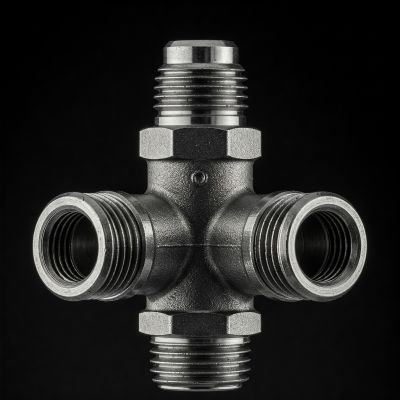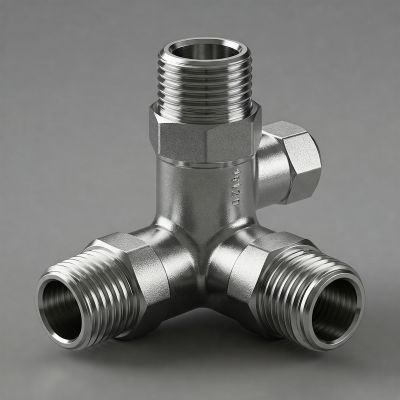Pipe fittings are essential components in various applications, from residential plumbing to industrial pipelines. They play a crucial role in connecting pipes, controlling flow, and ensuring the efficient operation of the entire system.
Among the many types of fittings, tee fittings are particularly common, offering versatile branching capabilities within a piping network. This article focuses on explaining the key differences between two primary types of tee fittings: tee run and tee branch.
What Are Tee Fittings?
Tee fittings, as the name suggests, are shaped like the letter “T,” with three outlets. They are primarily used to:
➡️ Combine: Merge fluid flow from two separate pipes into a single line.
➡️ Divert: Split fluid flow from a single line into two separate branches.
➡️ Introduce: Introduce a new branch line into an existing pipeline.
The two main types of tee fittings are:
➡️ Tee Run: Designed to primarily maintain continuous flow through the main line while allowing for a branch connection.
➡️ Tee Branch: Designed to efficiently divert a portion of the fluid flow from the main line into the branch.
Selecting the correct tee fitting is crucial for optimal system performance, ensuring efficient flow, minimizing pressure drops, and preventing potential issues like leaks or blockages.
Understanding Tee Run
A tee run, also known as a straight tee or standard tee, is characterized by its continuous flow path through the main line. The branch outlet, typically perpendicular to the main line, is designed to have minimal impact on the primary flow. This configuration makes tee runs ideal for:
➡️ Introducing new lines: Connecting a secondary line to the main pipeline without significantly disrupting the primary flow.
➡️ Maintaining flow priority: Ensuring that the majority of fluid continues through the main line.
➡️ Applications where minimal flow disruption is critical: Such as in high-pressure systems or those with sensitive flow requirements.
Understanding Tee Branch
A tee branch also referred to as a lateral tee or reducer tee, is specifically designed to divert a portion of the fluid flow from the main line into the branch. The branch outlet is often smaller in diameter than the main line, facilitating the controlled diversion of flow. Tee branches are commonly used in:
➡️ Splitting flow: Distributing fluid to multiple destinations within a system.
➡️ Reducing flow: Gradually decreasing the flow rate in a specific branch.
➡️ Applications where flow distribution is essential: Such as in irrigation systems, heating and cooling systems, and certain industrial processes.
Key Differences Between Tee Run and Tee Branch
➡️ Design:
➡ Tee Run: Maintains a consistent diameter throughout the main line with a minimal disruption to the primary flow.
➡ Tee Branch: Often incorporates a reduced diameter in the branch outlet to control flow diversion.
➡️ Functionality:
➡ Tee Run: Prioritizes continuous flow through the main line.
➡ Tee Branch: Prioritizes efficient diversion of flow into the branch.
➡️ Flow Direction:
➡ Tee Run: Minimizes disruption to the main flow direction.
➡ Tee Branch: Intentionally alters the flow direction by diverting a portion into the branch.
➡️ Applications:
➡ Tee Run: Ideal for maintaining primary flow, introducing new lines, and high-pressure systems.
➡ Tee Branch: Suitable for splitting flow, reducing flow, and applications requiring controlled flow distribution.
Factors to Consider When Choosing Between Tee Run and Tee Branch
➡️ System Type: The type of system (e.g., plumbing, hydraulic, industrial) will significantly influence the choice of tee fitting.
➡️ Flow Requirements: Evaluate the desired flow rate in the main line and the branch.
➡️ System Layout: Consider the overall system design and the specific requirements of each branch.
➡️ Material Compatibility: Ensure the chosen fitting is compatible with the fluids being transported and the system’s operating conditions.
➡️ Pressure Rating: Select a fitting with a pressure rating that exceeds the expected system pressure.
Common Mistakes and How to Avoid Them
➡️ Misidentifying fittings: Incorrectly identifying the type of tee fitting can lead to improper installation and system malfunctions.
➡️ Using the wrong fitting: Selecting a tee run when a tee branch is required, or vice versa, can result in inefficient flow, pressure drops, and potential system failures.
➡️ Tips for avoiding mistakes:
➡ Carefully review the system’s design and flow requirements.
➡ Consult with experienced professionals or refer to manufacturer’s guidelines.
➡ Inspect fittings carefully to ensure they are correctly identified.
➡ Ensure proper installation and secure connections.
Conclusion
Understanding the key differences between tee run and tee branch fittings is crucial for selecting the appropriate component for any given piping system. By carefully considering the specific requirements of the application, engineers and technicians can ensure optimal system performance, minimize potential issues, and maximize the efficiency of the entire system.
Post time: Feb-06-2025



